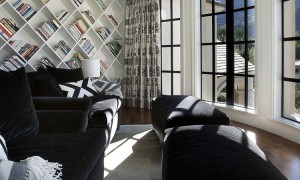Houzz Contributor, Gabrielle Di Stefano
Well-designed rooms often have a focal point — the first thing your eye sees when you enter. Choosing the right item to emphasize sets the tone and mood for a space. Whether it’s an architectural feature, a texture, a color or a light fixture, putting the spotlight on one of these elements will help create a visually interesting and pleasing interior. But what’s the best way to do this? Here are some ways to create a focal point that doesn’t dominate or compete with other objects in a space.
Architectural feature. A central element, like this fireplace, can help you position your furniture in a room. Notice how the furniture in this space revolves around the fireplace. The stone surround also sets the color tone for the sofa, chairs and drapes.
Getting the size of the architectural element right in the room is vital. If it’s too big, it can look and feel uncomfortable. If it’s too small, your furniture will become the focal point, taking away from the main feature.
Artwork. This painting is positioned perfectly — centered between the two doors, above the console — to create an instant focal point that allows the rest of the room to shine.
The size and tone of your art are important. Choose a painting with the appropriate scale for your space, in tones that stand out and draw the eye in but don’t clash with the rest of the room. One large, bold piece of art looks fantastic against a neutral wall and furniture. A series of prints can make an impact too, whether they’re framed identically or have an eclectic mix of frames.
View. When you have a view like this, use your home’s architecture to emphasize it and make it as big and grand as possible. This oversize window instantly makes the forest view the best focal point this room could have.
Choose simple furniture to complement a dream view like this. The minimalist bed and furniture allow the window to truly shine.
Revamp your space with a new bed
Texture. Add texture to create a focal point in a monochromatic color scheme, giving your room character and depth. Smooth, shiny objects will give off a cool vibe, while soft, raised textures add more warmth. This kitchen’s neutral, minimalist palette immediately draws the eye to the texture and color of the counter-to-ceiling backsplash. The tile finish glistens against the stainless steel appliances.
Find new tile that makes a statement
Pattern. Pattern can be a striking focal point. If a room is lacking in architectural features, use a more permanent, patterned finish — like tile or stone — as a bold statement.
The organic, flowing pattern and subtle color of the granite feature wall carries this powder room — no need for other decorative elements. Clever backlighting highlights the stone and emphasizes the floating vanity top.
Highlighting the ceiling with wallpaper adds interest and character to a room. Directing the eye upward also makes the room look bigger.
Color. Narrow hallways can feel dull, but painting the doors a gutsy color and adding texture with studs created multiple focal points in this one.
Pay attention to how you can use color on your home’s architectural elements to draw the eye to or away from certain parts of your home. Notice how emphasizing the skirting in this hallway with bright turquoise leads the eye from door to door.
One bold item, such as a colorful striped rug, instantly sets a playful mood. This look works particularly well in contemporary rooms with little or no architectural detailing.
Related Links:
Accessorize Your Focal Point With These Fireplace Tools
Find More Unique Focal Points in These Home Interior Photos
Frame Your View With Beautiful Valances













